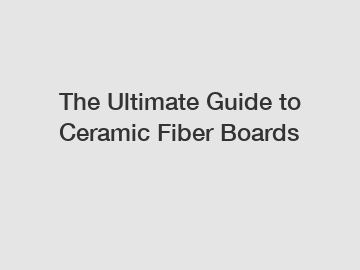The Ultimate Guide to Ceramic Fiber Boards
The Ultimate Guide to Ceramic Fiber Boards.
Ceramic fiber boards are a versatile and popular option for various industrial applications. They are known for their exceptional thermal insulation properties, high strength, and excellent resistance to thermal shock. In this ultimate guide, we will delve into everything you need to know about ceramic fiber boards, including their composition, applications, installation, and maintenance.
Composition of Ceramic Fiber Boards.

Ceramic fiber boards are primarily composed of alumina-silica fibers, which are mixed with inorganic binders and organic additives. The fibers used in these boards possess high chemical stability and are resistant to attack from most corrosive agents. This composition enables the boards to withstand high temperatures up to 3000°F (1650°C) while maintaining their structural integrity.
Applications of Ceramic Fiber Boards.
1. Furnace and kiln linings:
Ceramic fiber boards are widely used as insulation materials in furnace and kiln linings. Their high-temperature resistance and exceptional thermal insulation properties help to reduce heat loss and enhance energy efficiency in these industrial environments.
2. Fire protection:
Due to their ability to withstand extreme temperatures, ceramic fiber boards are also utilized in fire protection applications. They are used to construct fire doors, fire barriers, and other fire-resistant structures, ensuring the safety of occupants and minimizing property damage in the event of a fire.
3. Backup insulation:
Ceramic fiber boards are often used as backup insulation for refractory materials in various industrial processes. They provide an additional layer of protection against heat transfer and help maintain a stable temperature in equipment such as boilers, heaters, and incinerators.
Installation of Ceramic Fiber Boards.
When installing ceramic fiber boards, there are a few key considerations to keep in mind. It is essential to ensure a clean and dry installation surface, as any moisture or debris can affect the adhesive properties. The boards should be securely fastened using mechanical fixings, such as metal anchors or screws, to ensure stability. Proper sealing of joints with ceramic fiber paper or high-temperature adhesive tape is also crucial to prevent heat loss through gaps.
Maintenance of Ceramic Fiber Boards.
To ensure the longevity and optimal performance of ceramic fiber boards, regular inspections and maintenance are necessary. Checking for any signs of damage or wear and tear, such as cracks or disintegration, is essential. If any defects are detected, immediate replacement or repair is recommended to maintain the integrity of the insulation system. Additionally, periodic cleaning using a soft brush or compressed air can help remove dust and debris, preventing any potential blockages or reduced insulation efficiency.
Contact Us.
In conclusion, ceramic fiber boards are a reliable choice for industries requiring high-temperature insulation materials. Their composition, applications, installation, and maintenance have been discussed in this ultimate guide. If you have any further questions or would like to explore ceramic fiber board options, please do not hesitate to contact us. Our team of experts is ready to assist you in selecting the most suitable products for your specific needs.
The company is the world’s best refractory mortar, castable refractory cement, Fireclay Brick Recipe supplier. We are your one-stop shop for all needs. Our staff are highly-specialized and will help you find the product you need.
202
0
0


Comments
All Comments (0)